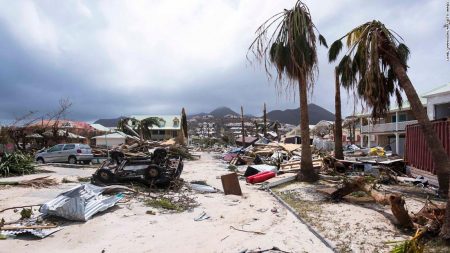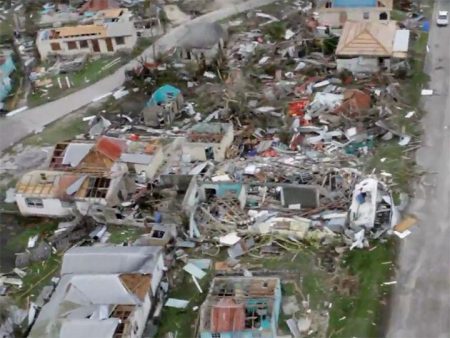By Ashford Daniel
The 2017 hurricane season is far from over, but already several Caribbean islands have had their future jeopardized by intense hurricanes in the space of a few days. Even the common man on the street, who is not schooled in meteorological information, will easily admit that this year has seen troubling, deadly unprecedented hurricanes.
And it continues.
We in St Vincent and the Grenadines had just held a concentrated series of response efforts to help Vincentians and other citizens in the BVI who were crippled by hurricane Irma. Physical donations were placed on an 1800 ton barge for the BVI. But before the vessel could have reached its destination, up pops hurricane Maria, forcing a speedy return to the safe waters of St Vincent and the Grenadines.
Now, even though this post focuses on the Caribbean, it is important to state that hurricanes Irma and Harvey (its predecessor) also brutally assaulted Texas, Louisiana and Florida, causing billions of dollars in accumulated damages. This acknowledgment is necessary so that a balanced perspective of the overall issue is not lost or trivialized in any way.


Of course, the Caribbean people are no strangers to hurricanes and tropical storms. But any blind man can see, as they say, that the frequency and intensity of the 2017 hurricanes have been abnormally shocking. There have been some hurricane seasons in the past when there were few–or no–hurricanes. And even when there was a hurricane or two, they were usually geographically spaced out and occurred far in time from each other.
But it looks like hurricanes no longer respect the Caribbean islands.
Right now, the BVI, Barbuda, the USVI, Puerto Rico and Dominica are all reeling from the effects of category five (major) hurricanes. In my living memory, we have never had multiple islands in need of regional and international help all at once.
The barge I mentioned earlier has left for a second time to deliver relief supplies to anxious relatives and friends in the BVI. Simultaneously, we are raising other relief resources to help Dominica.
My heart aches painfully for Dominica. They have suffered a double whammy!
On August 27, 2015, tropical storm Erika left at least thirty persons dead in Dominica with communities such as Petite Savannah all but buried under massive mudslides from torrential rains.
Two years later, on Monday September 18, 2017, hurricane Maria, packing category 5 winds of over 160 mph, took direct aim at Dominica and steered its small eye from the southern end to the top of the island with surgical precision.
As I saw the satellite imagery I could not believe it. The eye, flanked by the brunt of its most destructive winds, literally followed the contours and shape of the island to a T. It was as if hurricane Maria was a car in some child’s video game, and Dominica was its roadway.
Early in the storm, Dominica’s prime minister alerted Facebook followers that his own house roof had gone and that he was at “the complete mercy” of hurricane Maria. Around 2 AM on the morning of September 19th he told the regional and international community that his island and people will need all the help they can get because Dominica had “lost all that money can buy or replace”.
I also recognize a highly skilled friend in Dominica who tragically lost his house in 2015 when Erika brought down tons of mudslides on their house, burying his mom and dad instantly, while trapping his feet in the rocks. His dad’s body was never found.
Now an orphan, he and his surviving siblings (all young adults) have had to face the nightmare of Maria a mere two years later. This is a tragedy that one will not even desire for one’s enemies!
Can you imagine what it must feel like to be trying to rebuild your life after one tragic storm, only to be knocked down again by another disaster in such a short space of time?
As you can imagine, hurricane Maria completely knocked out all means of communication with Dominica, so there has been no word of that family’s fate; however, I trust that they did survive, and they are not numbered in the seven or so fatalities which I have heard about so far in Dominica.
At the time of this post, hurricane Maria is pounding the Dominican Republic and other nearby territories as it barrels northwards now. Meanwhile, radar images are showing non stop tropical activity in the eastern Atlantic ocean.
It is clear that we are not out of the woods as yet.
The speed with which Maria and Irma reached category 5 status has left everyone astounded. Some have even questioned whether or not somebody somewhere has found a way to manipulate weather systems. A plot which would make for a great James Bond film, no doubt.
Nonetheless, meteorologists are citing that the increasingly hot temperatures in the Atlantic Ocean is giving hurricanes a boost. There also seems to be little shear or high pressure systems which usually make it difficult for hurricanes in the tropics to develop into monsters.
After seeing the unbelievable way in which the eye of hurricane Maria navigated the island of Dominica, it has dawned on me that another such major category five hurricane can do another impossible thing in the Caribbean. That is, it can very well happen in the future that a hurricane, moving in a WNW direction, can pummel the Eastern Caribbean archipelago in one horrific slow-moving and deadly day.
Or night.
I also realize that most–if not all–of the times when a hurricane makes landfall, seems to be in the dark of night, as if the hurricanes know they must also generate panic, fear, and blindness to terrified citizens trapped beneath their destructive clutches of floods, wind and rain.
And even if one hurricane does not do this, it is also quite possible that several hurricanes can strike different islands in the same hurricane season. Or, each year might have one or two islands being disrupted again and again by natural disasters. And, like Dominica and the Virgin Islands, it might very well be that the same islands will be affected year after year.
The question is, therefore, how much rebuilding can small, generally helpless Caribbean islands sustain in an intensifying hurricane zone. I actually heard a citizen on Puerto Rico asking a television reporter this very question, because Puerto Rico had been affected by hurricane Irma just days before hurricane Maria knocked out all electricity on the island.
Incidentally, hurricane Irma had earlier made the water supply on Puerto Rico a scarce, scarce commodity.
Facing future hurricanes is now a matter of individual islands and regional security. It is not just something the Caribbean can entrust to each territory’s office of disaster management. Indeed, the head of the BVI’s disaster management acknowledged that their headquarters and equipment which they took over forty years to acquire, were all destroyed by hurricane Irma.
Caribbean citizens, from child to adult, must become immediately sensitized to environmental responsibilities and acts of protection and conservation. Studies in regional climate change impact is a must. The construction industry must galvanize support for creating structures that are more resistant to high winds and flooding. Additionally, each island (and the entire region) now needs not just a hurricane management or response plan, but general disaster coping and survival protocols.
Let me also say that we must begin to look closely at hurricane shelters. I do not think that every building that is owned or operated by government should automatically become a hurricane shelter. The same is true with churches. There are instances where existing hurricane shelters are also suffering similar damages and loss as the home from which many persons run away in the fist place.
Every local community also needs a disaster response and management group with persons trained and equipped to deal with some basic aftermath issues, such as medical and counseling. Every family should have access to hurricane shutters and knowledge of the kind of foods which can last without electricity, for about 4 days.
Let us not forget that the Caribbean is in an active earthquake zone. Many Caribbean islands have dormant and active volcanoes which each has the capacity to decimate the island it is on.
Right now Mexico is counting its dead from a major earthquake which hit even as hurricane Maria was beating up on the Caribbean. Who is to tell if in the future a hurricane and/or volcanic eruption will be affecting one or several small islands simultaneously in the Caribbean?
There has to now be a paradigm shift in leadership, education, corporate and civil collaboration, as well as a new thrust and partnership with the international community. Such a shift must go beyond individual islands’ politics. Now more than ever, Caricom and the OECS must have faith in each other and their abilities, otherwise I am afraid the fate of the Caribbean will be one of literal ruin and destruction. Presently, no human being is living on the island of Barbuda after hurricane Irma. Our human civilization in the Caribbean can be easily placed at risk of extinction by the onslaught of intensifying hurricanes in the Caribbean in future hurricane seasons.





